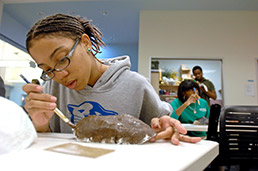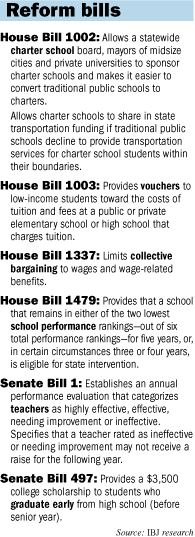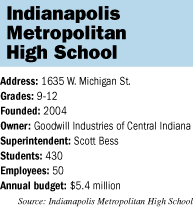Subscriber Benefit
As a subscriber you can listen to articles at work, in the car, or while you work out. Subscribe NowWhen students at Indianapolis Metropolitan High School got back from their holiday break this month, they returned to a school transformed.
In less than three months, administrators at the charter school decided to ditch their old educational model and implement a school-wide overhaul.
 Taylor Harris paints her mask in art class at Indianapolis Metropolitan High School, which overhauled its courses this month to improve students’ academic performance. (IBJ Photo/ Perry Reichanadter)
Taylor Harris paints her mask in art class at Indianapolis Metropolitan High School, which overhauled its courses this month to improve students’ academic performance. (IBJ Photo/ Perry Reichanadter)The reason was simple: The school’s 430 students weren’t hacking it on standardized tests. Only 3 percent passed the math test required for graduation and only 35 percent passed the required English exam.
Indy Met, as the school is called, has the flexibility to make such rapid change because, as a charter school, it is free from state curriculum and staffing regulations, as well as from collective bargaining agreements with its teachers.
“Painting the plane while it flies” is how Superintendent Scott Bess described the changes when he met with the school’s board of directors in November. The board, full of current and former business executives, heartily approved Bess’ proposal.
Indy Met could be the face of the future for all Indiana public schools.
Education reforms proposed by Gov. Mitch Daniels and Republican legislators would push all public schools to act more like charters: to make fast-paced changes to compete with their peers for grades from state regulators, as well as for the students and dollars that come with them.
Some question the wisdom of such rapid experimentation, while others say school improvement will come only through aggressive innovation.
Leaders at Indy Met expect to see early results of the effort in late April or early May, when scores from spring standardized testing come in. If they show improvement, school officials will plow ahead; if not, they’ll go back to their spreadsheets and whiteboards in search of another answer.
About the same time, Hoosiers will learn what broader education reforms get hashed out in the Indiana General Assembly—and what changes those will bring to Indiana schools.
In the meantime, IBJ will spend time at the Met, watching its transformation—bumps and all—to see many of the leading school reform ideas being tested in real life.
Traditional transformation
Before January, Indy Met looked more like an elementary than a high school.
Each grade level had its own separate school of about 100 students, housed in a different wing, with its own principal. All students had a primary teacher with whom they spent about half the day, working on projects and learning life and organizational skills. The rest of the time, they rotated among classes such as algebra, English and physics.
There were no bells at Indy Met, and few students bothered using their lockers.
In addition to leading instruction on a particular subject, each teacher acted as an adviser to the 15 or so students in his or her primary class—and remained assigned to them through their high school careers.
As quasi social workers, the teachers made visits to students’ homes, helped them through personal issues and, in some cases, became close confidants. Every teacher had a school-issued smart phone so students could reach them on nights and weekends, and teachers frequently were called out of class to help one of their students struggling with an emotional issue.
The relationship-based strategy was designed to help Indy Met’s students—most of whom are poor, most of whom are minorities, and most of whom didn’t thrive in traditional public schools—to succeed.
Indy Met’s challenging population is not unusual for charter schools. Although critics have raised concerns about charters' cherry-picking high achievers from traditional public schools, most are magnets for students who had trouble in other schools.
On Jan. 10, the first day of classes under Indy Met’s new structure, the bell rang for the first time at 8:30 a.m., signaling its shift in strategy. Students now change classes several times a day, have a different teacher for each subject, and use lockers instead of storing belongings in classrooms.
“Oh my god, this doesn’t feel like my old school,” junior Kehinde Ligali lamented as she looked at her schedule of seven classes and tried to figure out where to go for first-period physics. “It feels so different now.”
Indy Met’s leaders opted for a more traditional structure to allow teachers to make the academic program more rigorous.
After Bess decided on an overhaul, during a flight home from China in October, he assigned a group of teachers and deans to spend a month crafting a new structure for stronger academics.
As they spent another month working out logistics such as a master schedule in December, the school explained the changes to students and gave them a chance to ask questions. School leaders also sent parents phone messages and e-mails inviting them to attend forums to discuss the new approach and followed up with letters describing the new system.
The major changes: Students would be guided onto one of two tracks, either a college-prep path or a technical-skills-certification path. The teachers also would be split, either teaching or advising.
To guard against losing the school’s personal approach, leaders made sure all students have advisers who visit their homes and meet with them at least twice a week to provide support and guidance.
 “That’s our best shot at serving the population that we’re serving,” Bess said. “We didn’t want to re-create any high school model that you can get in the city.”
“That’s our best shot at serving the population that we’re serving,” Bess said. “We didn’t want to re-create any high school model that you can get in the city.”
‘The wheels came off’
The need for change at Indy Met became obvious last summer.
A larger-than-usual freshman class and new additions to the other grades brought about 200 new students to the school—nearly half the student body—and they struggled to acclimate to Indy Met’s unorthodox culture.
“We got off to a good start, and then it was almost like the wheels came off,” said Jim McClelland, CEO of Goodwill Industries of Central Indiana, which operates Indy Met. He noticed that too many students weren’t working well on their own, which the old Indy Met model required.
So he fired off an e-mail to Bess: “I’m not liking what I’m seeing. Let’s talk.”
Bess already knew changes were in order after he and his staff did a slew of number-crunching last summer in preparation for the city’s regular charter-renewal process. The mayor of Indianapolis is empowered to approve new charter schools and hold them accountable to improve students’ performance—or else to be shut down.
Indy Met has some things to brag about, to be sure, especially considering the tough population of students it serves.
It graduates about three out of every five students within four years—slightly higher than the 58-percent graduation rate of Indianapolis Public Schools, the district from which most Indy Met students come.
And Indy Met works to graduate more students—who typically arrive years behind their grade level—during a fifth year. By that measure, Indy Met graduates three out of every four students, far better than IPS’ five-year rate.
Indy Met also surveys students two years after graduation to see if they are still in school or have earned a degree. Last year, 69 percent of graduates were.
“That’s unheard of. No urban school has a persistence rate like that,” said city Charter Schools Director Karega Rausch, noting that urban schools nationally struggle to have 30 percent of their graduates carrying on with postsecondary training two years after high school.
But not all Indy Met’s numbers are rosy.
 Although the school prides itself on working with struggling kids and helping them catch up, at least by one measure it has been doing no such thing. Its students, on the whole, scored higher on their 8th-grade ISTEP tests—before coming to Indy Met—than they did on their graduation qualifying exams, which can be taken in grades 9-11. Those exams, called End of Course Assessments, test students in English and algebra.
Although the school prides itself on working with struggling kids and helping them catch up, at least by one measure it has been doing no such thing. Its students, on the whole, scored higher on their 8th-grade ISTEP tests—before coming to Indy Met—than they did on their graduation qualifying exams, which can be taken in grades 9-11. Those exams, called End of Course Assessments, test students in English and algebra.
Indy Met’s low pass rates are a big reason the school would not fare well on the A-through-F grading system state regulators plan to introduce this year. If that were in place now, Indy Met would get an F.
The data also showed that nearly one in four of Indy Met’s students was graduating with a waiver from the Indiana Department of Education because the student failed to pass required exams. The state will grant a waiver for students who have completed all required coursework.
And since nearly all the students who fail in their postsecondary endeavors graduated with a waiver, Indy Met aimed to have no more than 5 percent of its students require waivers.
“We could find no evidence that we were going to reach that goal under the current framework,” Bess told the Indy Met board when he pushed for approval of the school overhaul.
Innovate or experiment?
Indy Met’s aggressive changes come as state officials are attempting the biggest overhaul of public schools in a generation.
Daniels and Indiana public schools chief Tony Bennett are pushing for more charters, more competition between schools, more tracking of test data, and more innovation.
Some change has already hit in Indiana.
Ten years after the Legislature authorized the creation of publicly funded charter schools, 62 are operating across the state, including 26 in Indianapolis.
This year, traditional public schools also started competing for students after two new laws allowed all government funding for students to follow them wherever they go and no longer required schools to charge tuition to enrollees who live outside their district boundaries.
The state also has begun to implement a data system for tracking student performance, something mandated for all states who participated in a funding competition spurred by President Barack Obama’s administration.
The hope is that teachers, administrators and even parents will be able to see which schools and which methods are producing the best student test scores. The data will become public this year.
The next wave of changes would be even more dramatic—and controversial.
State lawmakers are proposing six education-reform bills this legislative session, including a proposal that would implement performance reviews for teachers and nix pay raises for those with lower ratings. Another would limit collective bargaining agreements so that administrators would have more freedom to implement changes to improve school performance.
Yet another would make it easier to create charter schools, provide them with more resources such as state transportation funding, and put in place stronger accountability metrics for them. Currently, charters have their operations, finances and student results evaluated annually by the entity that approves them.
But the legislation would give the state the right to intervene if a school receives a D or F grade three out of five years.
Speaking on that bill at a Jan. 19 hearing, Bennett talked about the need to “incubate innovation that meets the needs of children.”
“It’s really about the opportunity for the entrepreneurial spirit—risk-takers—to insert options into the educational system for our children,” he said.
Working in favor of reform this year is a Legislature controlled by Republican lawmakers, many of whom, like Bennett and Daniels, support the changes.
But the opposition also is intense. For instance, during the hearing where Bennett spoke, some Democratic lawmakers challenged the notion that charter schools are a remedy for the education system’s ills.
“Isn’t it a case of experimenting?” Vernon Smith, a Gary Democrat, said in response to Bennett’s comments about providing opportunities for risk-takers. Since most of the lowest-performing schools have high levels of poverty and large numbers of minority students, Smith added that, “Right now, we’re experimenting on low-achievers who might be minorities.”
Sudden shift

Some at Indy Met, in fact, weren’t initially sold on the shift, saying it felt like the school had reneged on its unusual approach to education.
Junior Makayla Catmull, for example, left Brownsburg High School after her freshman year because Indy Met’s model appealed to her. At first, she felt betrayed by the new direction—in particular how quickly it was carried out.
“I was frustrated with the fact that all of a sudden they changed it on us,” Catmull said. “I definitely would not have done it in the middle of the year.”
Her feeling underscores the concerns of some educational leaders.
Gerardo Gonzalez, dean of the education school at Indiana University, was generally supportive of the changes at Indy Met, but questioned the speed with which they were implemented.
He cautioned that, without basing the changes on solid research data, the result could be negative for students.
“Anytime you change a system, there’s going to be a period of adjustment. Young people are particularly vulnerable during transition periods,” Gonzelez said. “Those changes could have a life-long impact if they are not managed well.”
But Bess said the basic principles of the change are supported by two core tenants of educational research: setting high expectations and increasing time with quality teachers.
Making the structural shift quickly allows the school to learn from its mistakes and work to improve the process more swiftly, he said. It also forces students to adapt—as, Bess said, they started to do within the first couple of weeks.
After about a week, even Catmull started to like some aspects of the changes. She said teachers now have more time to help with her schoolwork since they’re not distracted by handling students’ personal issues.
Other pupils, however, still missed the old, work-at-your-own-pace model.
“I don’t like it. It takes away a lot of our freedom based on what we want to do in life,” said junior Tashiera McKissick, sitting in Indy Met’s bustling cafeteria. “You don’t really own your own education anymore.”
Some teachers had a different concern: Would students who so benefited from the intense relationship-building succeed under the new model?
Chad Miller, an enthusiastic Teach for America instructor who on the whole embraced the changes, said he’s not certain about the answer. In his old role, he drove one of his students to school every morning because he knew the student wouldn’t make it there otherwise.
Miller still intends to form close bonds with students, but having that intense level of involvement could be more difficult since he won’t be spending hours each day with them.
And the advisers who are working with students on a more personal level have about 60 to counsel.
“I worry if [some students] can make it in this structure,” Miller said, “just because they haven’t been successful in traditional schools.”
Bess said he thinks that critical piece of the mission will be kept intact. Building personal relationships with students has less to do with the structure of the school, he said, than the culture created and carried out by its people.
“Whereas before you kind of set it up to happen, relationships will happen in different ways now,” Bess said. “If 18 months from now, students feel that teachers only teach class, then we’ve failed.”•
Please enable JavaScript to view this content.
